My Life on Markham Hill
by Micheal Parks, Part 1 of 2
|
Community Radio show aired on KPSQ 97.3 FM: |
In 1972 I moved to Fayetteville from Shreveport to attend the University of Arkansas as a freshman. A friend of mine, Mimi Heinrich, who had lived across the street from me in Shreveport, now lived with her boyfriend on Markham Hill in the small garage studio that had previously housed Ms. Markham’s Rolls Royce. Mimi frequently talked about the joys of living on the 150-acre property that was walking distance to campus. I was thrilled to be in the Ozarks. Having grown up in the flatlands of the Red River in northwest Louisiana, I was naturally intrigued by my friend’s descriptions of life on Markham Hill. I investigated the possibilities of rentals on the hill and as it turned out, there was a large cabin that was available.
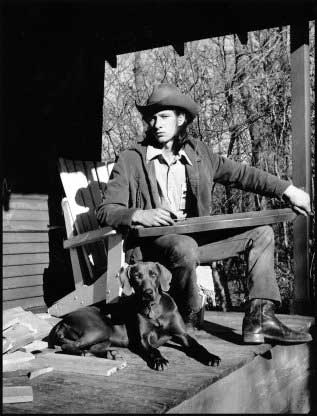
Tuning a dulcimer with my dog named Blue
on the porch of the big red cabin
My only heat in the winter was from an old pot-bellied wood stove and a gas kitchen stove. The cabin had no insulation, so a good down sleeping bag was essential as well. The kitchen was fairly large, with a nice large country stove, so I got into cooking and had some good times entertaining friends around the dining table and hanging out on the front porch.
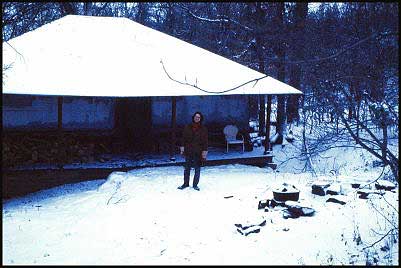
First snowfall at the red cabin
Up the hill from me, on the northeast side of the pasture, was another tiny little cabin tucked under a few trees. A guy named Jim Crow had fixed it up and lived there. Jim was bluegrass picker and I think he went on to become a pretty well-known bluegrass musician. Anyway, Jim was frequently down on the porch playing his guitar and we had some good times jamming with other musically inclined friends who would stop in from time-to-time. I played the banjo and the mountain dulcimer.
Now that I had a place in the woods, I thought I’d get a dog. A classmate had some blue Weimaraner pups for sale and I got one and named him Blue. Blue was a skittish dog and it seemed like someone had mistreated him, even though he was just a few months old when I brought him home. For a few months Blue stayed close to the cabin or inside while I was away at school. One winter day when I got home, I opened the front door and feathers exploded as if a bomb had gone off. Inside, there were tiny goose down feathers everywhere. Blue had entirely chewed up the sleeping bag. He laid sheepishly on the floor of the cabin when the feathers cleared, knowing full-well he had done wrong, all covered in the evidence.
In those days, Ms. Markham kept lots of guinea hens, which stayed together in a large flock most of the time. One day Ms. Markham called me up to the house to talk with me about her guineas. She loved her birds, along with her daffodils, and was concerned that her flock was mysteriously shrinking. Her suspicion of course was that Blue was getting them. I assured her that Blue would never do such a thing and besides, he stayed down at the cabin most of the time. “Well” she said, “please keep an eye on him. I wouldn’t want to lose any more guineas.” By that time, I had become friends with Ms. Markham and would do little things for her around the property. I did not want to be responsible for my dog killing her birds, so I was a little more watchful of where Blue went when he set off sniffing through the woods. As time went on, more and more of Ms. Markham’s guineas disappeared and her flock was getting noticeably smaller. It was a mystery.
Around this time, I became friends with a hippie carpenter named Lucas Cook who was living in Ward Pennington’s old residence at the far end of the pasture. Lucas drove an old 1948 Chevy truck and although we were supposed to park our vehicles in the parking lot by Ms. Markham’s house and walk to our cabins, Lucas frequently paid little attention to this directive and frequently drove his truck across the pasture so he could have access to his tools when he was at home. Lucas was always doing some kind of work back on the old Pennington place and I often walked back there to visit and see what new project he was up to.
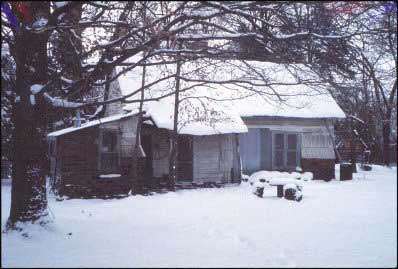
The old Pennington house when Lucas Cook lived there
Across the yard from the ramshackle Pennington house were two old log buildings. One was a small log cabin with a hand-laid stone foundation and the other was an old log barn that hadn’t been used in many years. They were both filled with all kinds of trash and collections of old newspapers and magazines that Ward Pennington had squirreled away for years when he was alive. The old barn was covered with so much trash you couldn’t even tell it was built of logs except for one corner of the building where the log saddle notches were exposed.
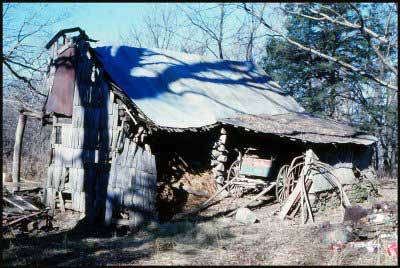
Ward Pennington’s log barn before I started working on it
One day when I went to see Lucas, he was cleaning out the cabin that was built on the stonework. It was a small building, only about ten by fifteen feet or so, but it had a charming look to it and was situated under a beautiful cedar tree. Lucas had emptied the cabin and was busy building a sleeping loft inside. The place had a primitive flagstone floor and Lucas had put in a wood stove. I had never paid much attention to the place before, but now, with Lucas’ handiwork, it was rather charming. After seeing what he had done with this place, I wondered what might be next with the old log barn.
After making it livable, Lucas moved into the log cabin in the late fall, mainly because it was too hard to keep the old Pennington house warm in the winter. The tiny cabin made a fine place to visit and warm up around the wood-burning stove after the occasional snowfall that would transform the hill into a winter wonderland.

Ward Pennington’s cabin after it was made livable
As winter progressed, Lucas started spending more time with his girlfriend who did not live on the hill. I was also learning about the difficulty of keeping my place warm with only a wood-burning stove. From what I remember, we had a lot of snow that winter and although it was beautiful, it was challenging. Getting up and down the hill on the ice-covered Markham Road was also stimulating, to say the least. We would frequently walk through snow to and from classes and even backpack our laundry to get that done.
In the spring, Lucas decided to move in with his girlfriend, away from Markham Hill. I immediately jumped at the chance to rent his little cabin. I had ideas about what could be done with the rest of the place and I liked the notion of living there. I thought I might live in the cabin for a while and eventually clean out and restore the old log barn that was behind the cabin.
These were busy days on the hill. It was around 1974 and people were always coming and going. All the cabins were occupied with interesting people and Ms. Markham seemed to delight in all the goings-on. She was in her bed most of time, becoming weaker and frail, but she would get daily reports from the people who lived there and was always interested in what was happening.
My friend Mimi and I both thought a community garden would be a good idea. We approached Ms. Markham with the proposal, and she gave us permission to install the garden under the water tower. Apparently, when Ms. Markham had given the city permission to place the water tower on Markham Hill, the city had agreed to let Ms. Markham use all the water she wanted without cost. As a result, we could put in a large garden in the fenced area around the water tower and have all the water we needed, whenever we wanted it.
The garden started out with a half a dozen or so of the hill’s occupants pitching in to help. We planted a huge vegetable garden and mulched it with hay from the barn. The vegetables grew quickly with an abundance of water, but so did the weeds that sprouted from the hay we used. Later in the summer, after a few weeks in the heat and the prolific weeds, the garden volunteer squad got smaller and smaller. Pretty soon it was whittled down to just a couple of us. So much for community gardening. By mid-summer garden upkeep had become overwhelming – we had put in a much bigger garden than we could handle.
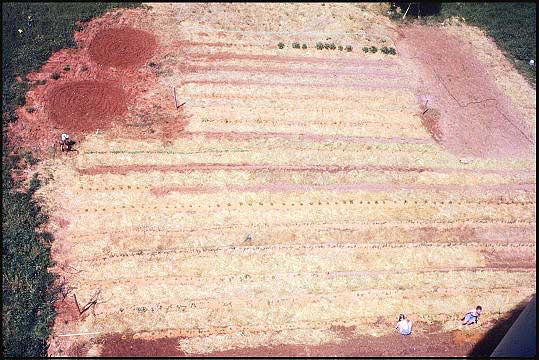
View of the community garden from atop the water tower
We ended up with a lot of squash and some tomatoes, but not much else. I suspect some of our early garden crew considered themselves entitled to partake in the harvest despite having dropped out of the effort involved to create it. That was the last and only time we put in a community garden.